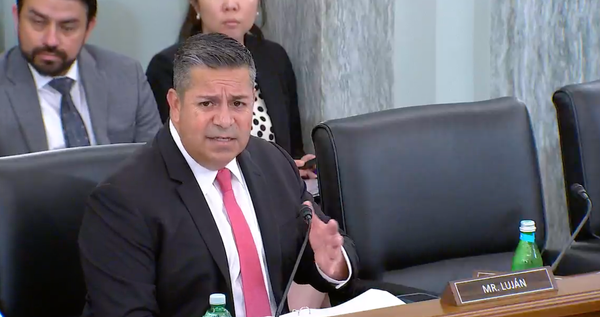Communications Workers of America Proposals to Stimulate Broadband Investment
WASHINGTON, January 9, 2009 – Communications Workers of America proposes government programs to stimulate broadband investment to create jobs and jumpstart the economy.
Broadband Documents
Communications Workers of America Proposals to Stimulate Broadband Investment
Editor’s Note: This document was provided by the Communications Workers of America on January 8, 2009. It is dated January 7, 2009, the the PDF of the document is available here. Or visit the BroadbandCensus.com Broadband Wiki.
Government programs to stimulate broadband investment will create jobs and help jumpstart our economy in the short-term while strengthening our nation’s competitiveness in the long-term. Every $5 billion invested in broadband infrastructure will generate 97,500 jobs in the telecommunications, computer, and IT sectors with multiplier effects throughout the economy. A seven percentage point increase in broadband adoption will create or save 2.4 million jobs annually. Accelerating the build-out of America’s advanced communications networks will assure economic growth, innovation, and job creation. Deployment of universal, affordable broadband also will help reduce health care costs, address our energy crisis, improve education and enhance the delivery of government services.
To be most effective, a broadband stimulus program should address: 1) slow broadband networks compared to our international competitors; 2) lack of broadband availability in rural areas; and 3) broadband affordability and digital illiteracy.
1. Fund S.1492, the Broadband Data Improvement Act (P.L. 110-385). Cost: $335 million over three years.
The House and Senate unanimously passed this legislation last session and the President signed the bill. It authorized grants to states to map broadband infrastructure and support demand-stimulation programs. However, Congress failed to allocate the funding needed to implement these programs. Since good data is required to effectively utilize limited resources, the broadband stimulus package should include funding for this legislation.
CWA recommends frontloading the funding based on the formula in the companion H.R. 3919, the Broadband Census of America Act that unanimously passed the House at a cost of $335 million over three years.
2. Temporary Broadband Investment Tax Credit for New Investment. By lowering the cost of capital, a broadband investment tax credit would encourage build-out in high-cost underserved rural areas and investment in next-generation high-speed networks. Each dollar invested in broadband due to the stimulus will result in several dollars of increased investment in other sectors because of “multiplier” effects.
How to structure tax incentives. A broadband investment tax credit program should be structured to incent two kinds of new broadband investment: 1) networks in rural unserved areas; and 2) high-speed advanced networks serving residential customers. CWA recommends tiering the incentives along these lines:
o New Investment in Rural and Underserved Areas. A 20% investment tax credit for additional investments in networks capable of at least 3 mbps down/1 mbps up.
o New Investment in Advanced Networks. A 40% tax credit for additional investments in networks capable of at least 20 mbps down/5 mbps up or advanced network capabilities.
o Investment tax credits should be available only for broadband capital expenses above 85 percent of the company’s previous year capex expense. (85% recognizes that in a recession, companies are likely to reduce capital expenditures between 10 and 20 percent). Companies should be required to demonstrate to the Department of Treasury that their 2009 capital investments are above 85% of the 2008 baseline. A similar process would be required for subsequent years. The program should last three years. (Companies that pay the Alternative Minimum Tax should also be eligible.)
3. Direct Grants to Support Rural Broadband. Unserved high-cost low-density rural areas will require additional support to make broadband build-out economic. CWA supports a program of matching grants, along the lines of the California Advanced Services Fund. Grant awards should be targeted to unserved areas, and priority given for higher speed investment. First priority should go to the private sector; if the private sector does not come forward, a public-private partnership or public entity could proceed.
4. Increase Broadband Adoption through Digital Literacy and Computer Ownership Many Americans report they do not subscribe to broadband even where it is available because they do not know how to access the Internet, do not see its value, or lack computer access. CWA supports several programs to address demand-side issues.
a. Tech Corps funded through grants to community-based organizations and libraries to fund tech corps members for digital outreach and training. 50 tech corps members in 100 locations = $250 million
b. Computer Microloans/Vouchers and Subsidized Broadband Access available through community-based or public programs to low-income households to purchase computers and receive free broadband access while they are paying off the microloan. The microloan option is modeled after a One Economy program. The voucher program should be means-tested, with distribution through schools, community-based organizations, unemployment offices, job training programs, and other agencies serving low-income households. The program can be implemented in conjunction with digital literacy programs, or programs such as those in Miami FL that provide free computers to middle- or high-school students who achieve academic success.
A $1 billion computer microloan/broadband access program reaching 4 million households could increase broadband access by six percent and result in 2 million new jobs.
c. Lifeline/Linkup subsidies for broadband access and equipment. The federal Universal Service Fund program of support for telephone service should be expanded to include subsidies for broadband access and equipment.
Broadband Investment Creates Jobs
Summary: Investment in broadband would create jobs, jumpstart our economy and improve our global competitiveness. For example, every $5 billion invested in broadband infrastructure would create 97,500 new jobs in the telecom, communications equipment, IT industries with multiplier effects throughout the economy in the year the investment is made. Broadband investment that leads to a seven percentage point increase in broadband adoption would create or save 2.4 million jobs throughout the economy.
Broadband and Job Creation • Multiplier effects. Every $5 billion increase in broadband investment would create 97,500 new jobs in telecom and IT with multiplier effects throughout the economy. Investment in broadband networks is comprised of network construction, equipment, and software. We use multiplier data from the U.S. Department of Commerce. While the exact “multiplier” effect of increased investment would depend on the precise mix, we estimate an employment multiplier of 19.5 for every $1 million invested.1
• Economic Jobs Impact. A seven percentage point increase in broadband penetration would create or save 2.4 million jobs throughout the economy. The indirect employment effects result from greater availability, increased competition, and lower prices. Based on Brookings Institution research, Connected Nation estimates 2.4 million new or saved jobs from a seven percentage point increase in broadband penetration.2
Additional Research on Broadband Jobs • According to a Department of Commerce study, communities with broadband added one percentage point to the employment growth rate, 0.5 percent to the growth of business establishments, and 0.5 percent to the share of IT establishments. 3
• A study of Appalachia found that firms in communities with broadband were 14 to 17 percent more productive than those in communities without high-speed Internet.4
1 Estimate based on RIMS II Model, Bureau of Economic Analysis, U.S. Department of Commerce; represents the average of the multipliers for Construction and Broadcasting and Communications Equipment ($5 billion x 19.5/$1million = 97,500 new jobs)
2 Connected Nation, “The Economic Impact of Stimulating Broadband Nationally,” Feb. 21, 2008 (http://www.connectednation.org/research/economic_impact_study/index.php). The Brookings study found that for every 1 percentage increase in broadband penetration, employment is projected to increase by 0.2 to 0.3 percent. Connected Nation found that broadband penetration increased seven percentage points above the national average in Kentucky (2005-2007) due to intensive demand-stimulation and network investment.
3 William Lehr, Carlos A. Osorio, Sharon E. Gillett, and Marvin Sirbu, “Measuring Broadband’s Economic Impact,” U.S. Department of Commerce, Economic Development Administration (Feb. 2006) (http://www.eda.gov/ImageCache/EDAPublic/documents/pdfdocs2006/mitcmubbimpactreport_2epdf/v1/mitcmubbi mpactreport.pdf)
4 Mark L. Burton and Michael J. Hicks, “The Residential and Commercial Benefits of Rural Broadband: Evidence from Central Appalachia,” June 2005, Paper prepared for the West Virginia Development Office, Center for Business and Economic Research, Marshall University










